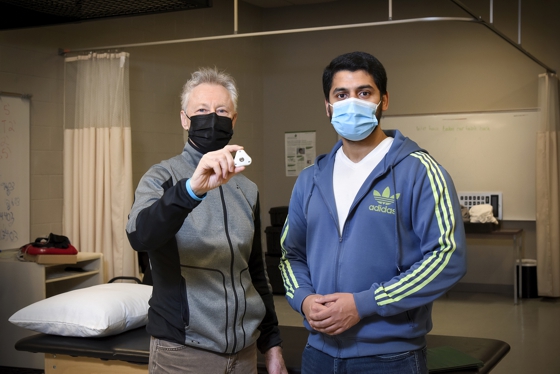
Kinesiology and Health Studies researchers Patrick Neary (left) and Jyotpal Singh are leading a study on COVID-19's effect on hearth health. Photo: U of R Photography
The University of Regina Faculty of Kinesiology and Health Studies is contributing to COVID-19 research by assessing the disease's impacts on the heart with a device that can fit in the palm of your hand.
"We want to characterize the COVID heart," says Patrick Neary, professor of Kinesiology and Health Studies.
Neary has worked with a small cardiac sensor, developed by LLA Technologies in Kelowna, B.C., over the last decade, using it to assess the impacts of concussions on the heart. Neary's PhD student, Jyotpal Singh, is using the sensor to study an expanded patient group. He's collecting data from people with cardiac injury, respiratory conditions, pneumonia, and those with and recovered from COVID-19.
"We are casting quite a wide net to see how we can differentiate between different conditions using this small, cardiac sensor," says Singh.
While the effects of the disease on the lungs are well known, with critically ill COVID-19 patients put on ventilators to keep them breathing, much less is known about effects on the heart.
"You really can't separate the heart from the lungs," says Neary.

As part of their COVID-19 research project, Patrick Neary (left) and Jyotpal Singh conduct an evaluation of heart health on one of the study's volunteers. Photo by U of R Photography
The goal is to use the senor to collect enough data to see if there is a noticeable pattern of cardiac response in COVID-19 patients. If there is then the sensor could become a useful tool when triaging patients in healthcare.
The echocardiogram is currently the "gold standard" when assessing the heart health of COVID-19 patients in the hospital, says Neary. But it takes an hour to do and is expensive. LLA's sensor only takes a minute to collect similar data.
"We do know the heart is affected by COVID-19," says Neary. "We're hoping to illustrate that quickly and effectively."
Singh says the fact the device can be shipped anywhere also makes it effective for assessing patients in rural areas who might have to drive hours for an echocardiogram.
"The device is very simple to use," says Singh. "We can instruct people over the phone. They can keep to their daily routines."
The sensor sticks to a patient's sternum with an electrode while he or she lays down for one minute, once a day, for up to 14 consecutive days. It records data about the mechanics of the heart and allows Singh to assess overall heart fitness with a number called the Heart Performance Index. People with cardiac injuries like heart attacks or heart failure have numbers that deviate far from "normal" Heart Performance Index values.
"We're looking to see where the COVID patients end up," says Neary.
Current research shows a massive respiratory response in COVID-19 patients that causes inflammation, which then affects the heart, Singh says. Indicators or "biomarkers" of cardiac injury are shown to be elevated in COVID-19 patients, but evidence is case by case.
"A lot of the research is variable," says Singh. "It's tough right now to try and pinpoint exactly one type of response. More research is required to be certain of what's going on."
To get devices on patients, Singh and Neary are partnering with physicians and cardiologists in hospitals and medical clinics in Regina, Alberta, and B.C. Neary says that care homes in Ontario have also reached out to be part of the research. Currently 100 sensors have been shipped, around half of Singh's goal to have 200 participants in the study.
Singh also expects to make a connection between this study and previous research he co-authored two years ago on the effects of acute hypoxia (depletion of oxygen in the blood) on the heart. Using the Kinesiology lab's hypoxia chamber to simulate an environment with less oxygen, participants wore the small cardiac sensor for 30 minutes in the chamber. From the data, Singh concluded that hypoxia negatively affects the mechanics of the heart.
"With COVID-19 we see a similar hypoxia-type effect in individuals, so we're pretty certain we will draw some parallels," he says.
At this stage in his academic career, Singh says his current research is the most ground-breaking.
"Advancing science or technology fascinates me," he says. "It's exciting to take what we look at theoretically in the lab and apply it to a real-life setting in the healthcare system, where we can help try to ease stress."
The research is funded through MITACS, a non-profit organization that partners with industry and provincial and federal governments to deliver research training and programs across the country. Over the past year, funding from government for COVID-19 research-based projects quadrupled. Neary received $45,000 to complete the project over the next year.
"We are thankful that LLA Technologies agreed to give us these devices to use and collect data in the lab," says Neary.
Singh says feedback from participants has been positive so far.
"They let us know how the research helps them better understand how their body is working," he says.













